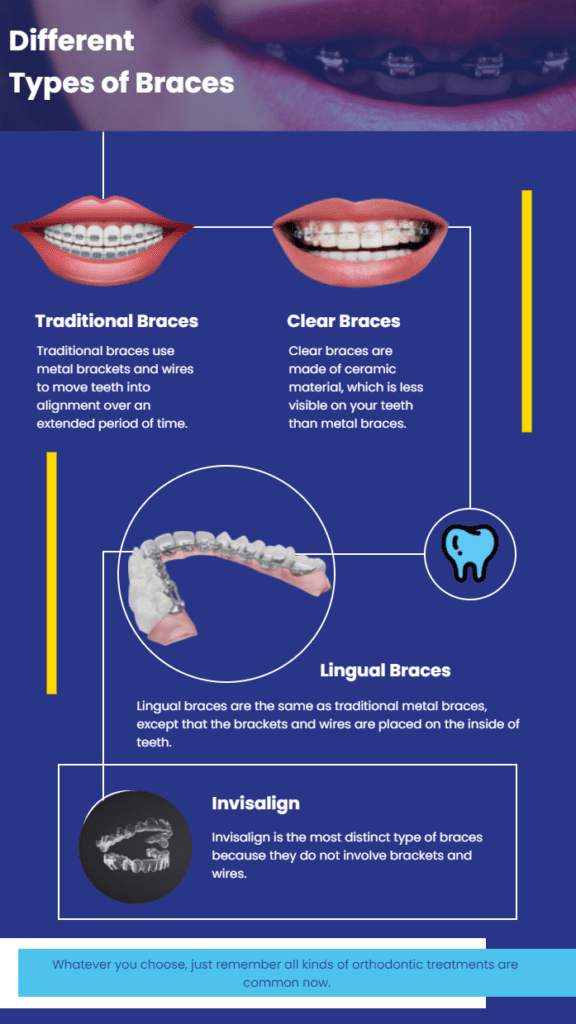How Cumming Orthodontics Can Transform Your Smile with Invisalign and Braces
How Cumming Orthodontics Can Transform Your Smile with Invisalign and Braces
Blog Article
Comprehensive Guide to Orthodontics Procedures for Remedying Oral Imbalances
In the world of orthodontics, the journey to accomplishing a completely aligned smile includes a myriad of procedures customized to fix oral misalignments. From traditional braces to unnoticeable aligners and even surgical options, the field of orthodontics provides a series of options to attend to differing levels of oral abnormalities. Comprehending the ins and outs of each treatment, including their systems, advantages, and prospective disadvantages, is vital in making educated choices regarding one's orthodontic treatment. As we navigate through the comprehensive guide to orthodontic treatments for dealing with oral imbalances, the intricate information of each approach will certainly unfold, clarifying the course towards a unified and practical oral alignment.
Orthodontic Procedures Review

Along with clear aligners and conventional dental braces, orthodontists might likewise advise other treatments like headgear, palatal expanders, or retainers to resolve particular placement concerns (orthodontics). These procedures are tailored to every person's unique requirements and might entail a mix of treatments to accomplish the wanted outcomes. Regular adjustments and tracking are critical parts of orthodontic therapy to make sure progression gets on track and to make any essential adjustments in the process. By going through orthodontic treatments, people can not only achieve a straighter smile yet also improve their overall oral health and wellness and function.
Typical Dental Braces: How They Work
When taking into consideration orthodontic treatments for oral imbalances, typical braces stand out as a tried and true approach for correcting teeth positioning. Typical braces are composed of braces, cords, and bands that work together to apply constant pressure on the teeth, slowly relocating them right into the wanted alignment.
As stress is used to the teeth via the dental braces, the bone bordering the teeth is reshaped to support the new tooth positions. Individuals will require routine changes at the orthodontist's office to make sure the dental braces proceed to apply the appropriate pressure for effective teeth activity.
Unseen Aligners: Disadvantages and pros
Unseen aligners use a hassle-free and very discreet option to traditional braces for dealing with oral misalignments. These clear, customized trays are virtually unseen when used, making them an enticing option for individuals looking for a much more aesthetically pleasing orthodontic therapy. One of the primary advantages of unseen aligners is their removability, enabling easier upkeep of oral health compared to typical dental braces. Patients can get rid of the aligners before consuming or brushing their teeth, lowering the danger of food getting embeded the appliance and streamlining the cleaning process.

Surgical Orthodontic Options
Surgical treatments in orthodontics existing feasible choices for attending to complicated dental imbalances that might not be successfully dealt with with conventional orthodontic therapies. While unnoticeable aligners and traditional dental braces can correct many orthodontic concerns, specific cases call for medical intervention to attain ideal outcomes. Surgical orthodontic choices are generally recommended for extreme malocclusions, considerable jaw discrepancies, and instances where the underlying bone framework requires adjustment to achieve correct positioning.
One common medical orthodontic treatment is orthognathic surgical treatment, which includes rearranging the jaws to remedy functional concerns such as difficulty talking or chewing. This surgical treatment is frequently executed in partnership with an orthodontist that helps straighten the teeth before and after the treatment. Surgical orthodontics may additionally include treatments to expose web influenced teeth, remove excess periodontal cells, or reshape the jawbone to develop a more unified face profile.
Prior to considering medical orthodontic alternatives, clients undertake a detailed this link assessment to establish the necessity and prospective advantages of such interventions. invisalign. While surgical procedure might seem challenging, it can considerably enhance both the function and looks of the smile in instances where conventional orthodontic treatments fail
Retainers and Post-Treatment Treatment

Failure to comply with post-treatment treatment guidelines can result in relapse, where the teeth gradually relocate back in the direction of their original positions. Regular retainer wear, excellent dental hygiene, and normal oral examinations are important for maintaining the outcomes accomplished through orthodontic surgical procedure and making certain the long-lasting stability of the dealt with dental alignment.
Verdict
To conclude, orthodontic procedures use various alternatives for dealing with dental imbalances. Standard braces make use of steel brackets and cords to move teeth into correct placement. Undetectable aligners provide an even more discreet choice however might not be appropriate for all cases. Surgical orthodontic choices are available for a lot more severe imbalances. Retainers are typically used post-treatment to keep the new positioning. Overall, go to my blog orthodontic procedures can properly enhance oral health and visual look.
As we navigate through the extensive guide to orthodontic treatments for correcting dental imbalances, the intricate details of each technique will certainly unravel, shedding light on the course toward a harmonious and practical oral positioning. - cumming invisalign
One of the most common orthodontic treatments is the usage of dental braces, which consist of metal brackets and wires that apply gentle pressure to slowly move teeth right into the wanted placement.When considering orthodontic treatments for dental misalignments, standard dental braces stand out as a tried and true approach for correcting teeth positioning. Furthermore, invisible aligners might not be ideal for complicated orthodontic issues that require more considerable teeth motion, as they are normally advised for moderate to moderate situations. Retainers are customized orthodontic gadgets made to hold teeth in their corrected positions after the conclusion of orthodontic therapy.
Report this page